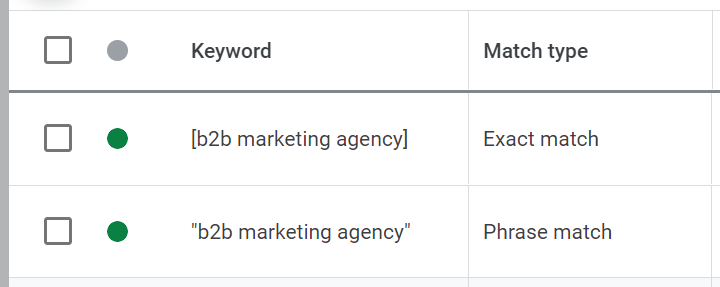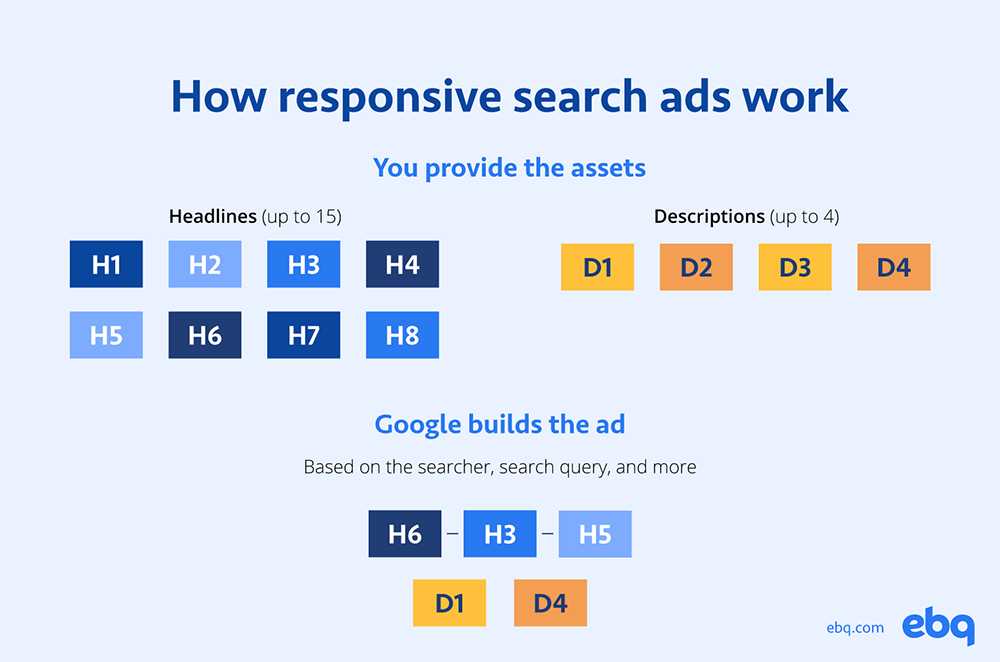Google Ads is one of the most popular pay-per-click (PPC) advertising platforms in the digital marketing space. In fact, studies show that the average ROI of Google Ads is 200%.
So how can your B2B get similar results? You’ll need to make sure your Google Ads campaigns are set up correctly and fully optimized.
Here are 5 tips to help your B2B get the most relevant leads from Google Ads:
- Strengthen keyword bidding strategy
- Optimize ad group strategy
- Improve Quality Score
- Leverage Google’s machine learning
- Retarget website visitors

B2B Marketing Strategy Framework: The Ultimate Guide to Business Branding
Looking to create a strong B2B marketing strategy? This guide walks you through planning a data-driven marketing campaign.
First, let’s start with the biggest tip of all: improving your keyword strategy.
1. Strengthen keyword bidding strategy
The first secret to maximizing ROI is optimizing your keyword strategy.
Keywords are used to match your ads to the terms people search for. To brush up on the foundations of Google Ads, be sure to check out our post covering the B2B Google Ads basics.
One best practice is to bid on long-tail keywords — a string of 3 or more words that users input into a search engine. That’s because long-tail keywords are more specific, are often easier to rank, and can help you gauge search intent.
As an example, a searcher who enters “b2b marketing agency” is likely looking to hire an outsourced firm to handle their marketing needs. Compare that to a search for “b2b marketing,” where the user could possibly just be looking for education.
For PPC campaigns, focus on transactional keywords — keywords that show that the user is ready to purchase a solution. Unlike organic search, you’re paying for these keywords, so make sure you spend your budget on those who are most likely to convert.
After deciding on which keywords to bid on, it’s time to determine how to utilize Google’s keyword match types to your advantage.
What are the keyword match types?
In Google Ads, there are 3 types of keyword matching: broad match, phrase match, and exact match. As you input your keywords, you can indicate which match type to use by using brackets, quotation marks, or neither.
![A graphic displaying the three types of Google keyword matches, from loosest to tightest matching (broad match > phrase match > exact match) Broad match notation for inputting keywords: keyword Phrase match notation for inputting keywords: "keyword" Exact match notation for inputting keywords: [keyword]](https://ebq.com/wp-content/uploads/2022/12/Keyword-Match-Graphic.png)
- Broad match: The default keyword match type, this allows you to rank for searches related to the keywords you input but that may not have the same meaning.
- Phrase match: This keyword match type allows your ad to show for searches that include the exact meaning of your keyword but may include additional words in the query.
- Exact match: Just as the name implies, this will show your ad for searches that match the meaning of your keyword exactly.
Determining the right keyword match types to use can depend on how specific your keywords are, the competitiveness of your niche, and your ad group strategy.
Negative keywords
From there, you can also input negative keywords — which are keywords you don’t want to bid for. That way, you can weed out irrelevant searchers who have no chance of converting.
Here are some examples of popular negative keywords used in a B2B setting:
- Career
- Job openings
- Free
- Cheap
- Used
After you’ve run your campaign for a few weeks, you can view which search terms your ads come up for most often. Then, make sure you set up any irrelevant terms in the list as negative keywords to not spend more money on them.
Budget strategy
Because it’s such a costly landscape to bid on B2B keywords, we recommend starting with a small budget. From there, you can gather data and ramp up appropriately based on metrics such as conversion rate and cost per conversion.
To get a better understanding of how much keywords can cost your organization, Google Ads provides a Keyword Planner. This free tool allows you to see how much your keywords historically cost. Google will then recommend certain budget strategies based on your campaign goals — such as what time your ad should show up on search results.
After selecting which keywords to target, it’s now time to optimize your ad groups to maximize conversions.
2. Optimize ad group strategy
Why is optimizing your ad groups so important? It’s to ensure you’re serving the right ads to prospects with a higher chance of converting. Remember: you can have 10,000 campaigns per account, 20,000 ad groups per campaign, and 50 text ads per ad group. Therefore, you’re meant to get as granular as possible with your ad groups.
One best practice is to group keywords together that can be addressed by the same ad. This is to make sure your ads are shown to users with the same search intent. Otherwise, you’ll need to separate these keywords into multiple ad groups.
So how should you group keywords together? There are 2 effective ad group strategies we’ll outline here: Single Keyword Ad Group (SKAG) and Single Theme Ad Group (STAG).
SKAG vs. STAG
In the past, Google asked advertisers to input 10-20 keywords into a singular ad group. However, many advertisers argue that this makes creating relevant ads difficult — as these 10-20 keywords can cover a wide range of search intent.
After all, the purpose of ad groups is to allow advertisers to drill down on groups of keywords that can be answered with a singular ad.
Here are 2 ways to effectively group keywords together:
- SKAG (Single Keyword Ad Group): Focuses on a singular keyword, so your ad copy can match the term exactly.
- STAG (Single Theme Ad Group): Groups multiple keywords together by search intent, so your ad copy can match search intent.
These strategies ensure that your ad closely matches the searcher’s expectations. They can help you maximize your PPC budget by ensuring your ads are more likely to show for relevant searches.
For example, let’s say we at EBQ — a B2B sales and marketing outsourcing company — want to create Google Ads.
If we utilize SKAG, our focus is to target one singular keyword and focus on keyword match types. In this case, we’re trying to target the keyword “b2b marketing agency.”

As you can see, we’re focusing our efforts on phrase and exact keyword matches. That way, we can capture anyone who inputs “b2b marketing agency” as their search term — or part of their search term.
If we wanted to focus on targeting how searchers are looking for their solution, then STAG could be the better option. For example, we can create different ad groups for people looking for a marketing agency for SEO versus a marketing agency for email marketing.
Keywords in our “SEO” ad group could include:
- B2B SEO marketing agency
- SEO marketing services for B2B
- Outsourced B2B SEO marketing
And keywords in our “email marketing” ad group could include:
- B2B email marketing agency
- email marketing services for B2B
- outsourced B2B email marketing
At the end of the day, Google cares primarily about catering their search results to answer search intent. Ultimately, you should focus on the ad group setup that allows your advertisers to easily create a singular ad that answers all the keywords listed in your ad group.
Take a look at Wellview’s marketing portfolio as an example. They needed to draw in partnership opportunities from organizations looking to improve their health management solution, so EBQ helped them create targeted ad groups around specific facets of their business. As a result, EBQ helped Wellview build a dependable pipeline.
Now that we’ve spoken extensively on how to set up your ad campaigns, let’s look at ways to improve your ad quality using Google’s benchmarks.
3. Improve Quality Score
Quality Score is Google’s indicator of how well your Google Ad will perform compared to competitors at a keyword level. While this score isn’t meant to be a key performance indicator, it can still affect your final ad rank.
What is Quality Score?
Quality Score is made of 3 components:
- Expected CTR: How likely it is that a searcher will click on your ad.
- Ad relevance: How relevant your ad is to the search intent of the keyword.
- Landing page experience: How relevant your landing page is and how it performs after the prospect clicks on your site.
For each of these components, you’ll be given a status of either “Below average,” “Average,” or “Above average.” It is recommended that you optimize your ad if any aspects of your ad fall below the “Above average” rating.

So why should you care about the Quality Score of your ad? It’s because Quality Score directly affects your Ad Rank: where your ad will ultimately rank on the SERP.
The formula that determines your final Ad Rank is [Bid] x [Quality Score] = [Ad Rank].
![[Ad Rank] = [CPC Bid] x [Quality Score]](https://ebq.com/wp-content/uploads/2022/12/Ad-Rank-Formula-Graphic.png)
What can you do if any of your 3 components fall below “Above average”? Here’s a table of how to optimize your ad based on which component needs optimization:
| Google Ads Component | Best Practices |
|---|---|
| If the expected CTR is low |
|
| If your ad relevance is low |
|
| If your landing page experience is low |
|
If you’re looking to improve your ad copy, be sure to look at your Ad Strength. When setting up your ad copy, you can use Ad Strength to get real-time feedback on what to improve on in order to provide your customers with the right messaging. Ad Strength rates your ad’s relevance, quality, and diversity of the ad copy.
After approaching your PPC campaigns with a more hands-on approach, it’s time to rely on Google’s technology to help you optimize your ads.
4. Leverage Google’s machine learning
The reason why Google has such a dominant market share is because of their search engine algorithm. While Google likes to keep their algorithm ambiguous, you can still leverage its machine-learning capabilities to boost your Google Ads ROI.
If you’re planning to use Google search ads, we recommend looking into both Responsive Search Ads and Dynamic Search Ads.
Responsive search ads
For responsive search ads, Google takes your variations of headlines and ad copies to combine them into 1 ad. Then, Google tests these variations and focuses on the winning combination.
To make sure you’re taking full advantage of responsive search ads, make sure every combination of headlines and ad copy makes sense. As long as the Ad Strength score is hitting “Good” or higher, your responsive ad can be considered effective.

Dynamic search ads
Dynamic search ads work by automatically populating an ad by pulling data directly from your website. This means that your web developers must make sure your site is technically optimized by using SCHEMA markup correctly. It’s important to note that dynamic search ads are not ideal for websites that regularly update. That’s because Google would not regularly pull information from your site to help you build new and relevant ads.
Using broad matches
As we mentioned earlier, consider leveraging Google’s broad matches. This keyword match allows you to rank for keywords that you didn’t directly input into your ad groups, but Google has determined that the broadly matched keywords still match the intent of your searchers. However, be aware that you might be ranking for broad matches that aren’t relevant to your ad. That’s why it’s important to continuously revise and improve your keyword strategy.
Performance Max ads
Finally, look into Performance Max campaigns — where you can advertise on Google’s various platforms using one singular campaign. After indicating what your campaign goals are, you’ll then upload all of your assets — such as images, videos, headlines, and ad copy — into an asset group. From there, Google will mix and match your assets to see which final ad performs the best.
5. Retarget website visitors
One study has shown that only 4% of visitors who are on your site are ready to buy. This means that the majority of your website visitors are nowhere near ready to convert.
But that doesn’t mean all hope is lost. The key here is to stay top of mind by retargeting those who are already aware of your brand and considering your solution. By retargeting those audience segments, you’ll be able to push these prospects further down the buyer’s journey.
In Google Ads, there are 2 types of retargeting ads that you can take advantage of:
- Pixel-based targeting: The more traditional kind of retargeting. These use cookies to store searchers’ browsing behavior. After visitors leave your site, you can create a specific ad to retarget them.
- List-based targeting: The manual way of retargeting. After gathering a list of emails through other marketing activities, you can create highly personalized ads to target these prospects and stay top of mind.
To make sure you’re properly retargeting prospects, we recommend working with experienced web developers and digital marketers. For example, EBQ can provide an entire marketing department — including content, design, digital, and web services — for a fraction of the cost of hiring internally. Not only do our specialists work with a wide range of industries, but we also stay up to date on industry trends to help you get in front of the right people.

B2B Marketing Strategy Framework: The Ultimate Guide to Business Branding
Looking to create a strong B2B marketing strategy? This guide walks you through planning a data-driven marketing campaign.
Develop a winning B2B Google Ads strategy
Google Ads is a powerful tool that allows you to get in front of people who are looking for your solution — but only if you know how to optimize your ad campaigns.
If you’re looking to boost conversions, be sure to review the following strategies:
- Strengthen keyword bidding strategy
- Optimize ad group strategy
- Improve Quality Score
- Leverage Google’s machine learning
- Retarget website visitors
Struggling with Google Ads? EBQ offers a digital marketing service to help you create high-quality ads and generate more leads. You’ll also get to work with a Project Manager and Success Manager who will oversee the daily strategy of your project — freeing up time for you to focus on the bigger picture.


